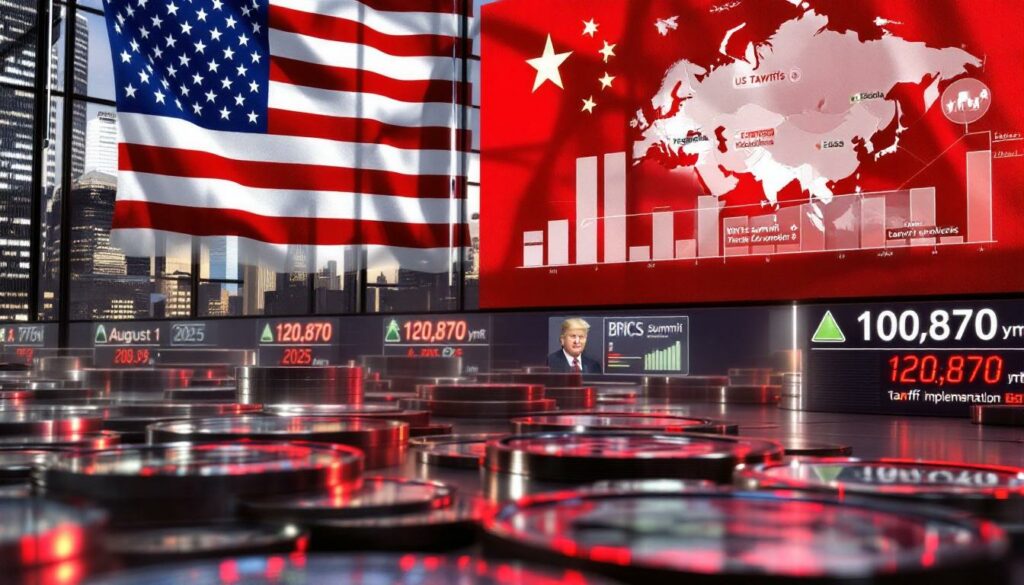How Are US Tariff Policies Affecting Nickel Prices?
The global nickel market is experiencing significant turbulence as the United States prepares to implement new tariff policies. These developments are creating ripple effects across international metals markets, with particular impact on nickel prices and US tariffs and trading patterns.
The August 1 Tariff Implementation Timeline
US tariffs on various metals and goods, including nickel, are scheduled to take effect on August 1, 2025. This deadline represents a critical juncture for global metals trade, as countries that fail to reach trade agreements with the US will see tariffs revert to April 2025 levels, potentially disrupting established supply chains.
According to US Commerce Secretary Lutnick, "Tariffs will take effect on August 1, and Trump is now setting tariff rates and agreements." This confirms that Trump critical minerals administration officials are currently finalizing tariff rates while simultaneously conducting trade negotiations with key partners and suppliers.
White House economic advisor Hassett has indicated that some trade negotiations may extend beyond the August 1 deadline, creating a period of extended uncertainty for market participants. Meanwhile, US Treasury Secretary Bessent has offered a more optimistic outlook, stating that "multiple major agreements are close to being reached."
Market Insight: The approaching deadline has created a bifurcated market response—some traders are building inventory in anticipation of higher costs, while others are delaying purchases until policy clarity emerges.
Recent Price Movements in the Nickel Market
Nickel prices experienced a significant decline on July 7, 2025, demonstrating the market's sensitivity to tariff-related news. The Shanghai Metals Market (SMM) 1# refined nickel price dropped to 120,700-123,300 yuan/mt, with the average price falling by 1,450 yuan/mt to 122,000 yuan/mt compared to the previous trading day.
In futures markets, the most-traded SHFE nickel contract (2508) declined by 1.31% to 120,870 yuan/mt in midday trading on the same day, reflecting broader market anxiety. This price action came immediately after reports of finalized tariff rates being prepared by the administration.
Key price movements (July 7, 2025):
| Product | Price | Change |
|---|---|---|
| SMM 1# refined nickel | 120,700-123,300 yuan/mt | -1,450 yuan/mt |
| SHFE nickel contract (2508) | 120,870 yuan/mt | -1.31% |
Traders report that the nickel market began showing signs of distress in late June, as the tariff implementation date approached with few concrete details about exemptions or rates.
What's Driving Current Nickel Price Volatility?
The nickel market is currently experiencing heightened volatility driven by a complex mix of geopolitical, policy, and market factors. Understanding these drivers is essential for stakeholders navigating this challenging environment.
US Trade Policy Uncertainty
The approaching July 9 global tariff deadline has significantly increased market anxiety. This policy uncertainty has emerged as the dominant factor suppressing nickel prices, overshadowing fundamental supply-demand dynamics.
Statements from key US officials have done little to quell market concerns. While Treasury Secretary Bessent has indicated multiple major agreements are close to being reached, Commerce Secretary Lutnick confirmed Trump is "now setting tariff rates and agreements," suggesting final decisions remain in flux.
The uncertainty centers around which countries will secure agreements before implementation, with major nickel producers like Indonesia and Russia potentially facing significant impacts. This ambiguity has prompted defensive positioning among traders and consumers.
Analyst Perspective: "The metals market is currently pricing in policy risk over fundamentals—a reversal of typical market behavior that usually prioritizes supply-demand dynamics." – SMM Market Analysis Team
Market Sentiment Indicators
Heightened risk aversion sentiment is visibly suppressing nickel's price rebound potential. SMM analysts project nickel prices may oscillate within the 118,000-123,000 yuan/mt range in the short term, reflecting the market's cautious stance.
The technical picture shows clear support and resistance levels have formed, with 118,000 yuan/mt serving as a psychological floor and 123,000 yuan/mt acting as a ceiling. Breaking through either level could signal a significant shift in market sentiment.
Trading volumes have declined approximately 12% from June averages as participants adopt a wait-and-see approach ahead of the tariff implementation. This reduced liquidity further contributes to potential price swings.
Premium and Discount Fluctuations
Premium and discount spreads serve as critical barometers of physical market conditions. Recent data shows Jinchuan #1 refined nickel premium averaged 2,050 yuan/mt, down 50 yuan/mt from previous trading, with the premium quotation range narrowing to 1,900-2,200 yuan/mt.
Meanwhile, electrodeposited nickel from domestic brands is trading between -200 to 300 yuan/mt premium/discount, indicating uncertain physical market conditions. This premium compression points to market uncertainty about direction and reflects buyers' reluctance to commit to large purchases.
Premium/Discount Trends (July 7, 2025):
| Product Type | Premium/Discount | Change |
|---|---|---|
| Jinchuan #1 refined nickel | 2,050 yuan/mt premium | -50 yuan/mt |
| Electrodeposited nickel | -200 to 300 yuan/mt | Widening range |
These fluctuations in premiums and discounts provide early signals of changing market dynamics, often preceding movements in the broader market price.
How Might International Relations Impact Nickel Markets?
The nickel market exists within a complex web of international relations, with recent diplomatic developments potentially reshaping trade flows and pricing dynamics.
BRICS Summit Developments
The 17th BRICS Leaders' Summit in Rio de Janeiro on July 6, 2025, took place against the backdrop of escalating trade tensions. Chinese Premier Li Qiang delivered a notable speech focusing on "Peace and Security, Global Governance Reform," signaling potential shifts in international economic cooperation.
The summit adopted the "Rio de Janeiro Declaration," which, while not specifically addressing metals trade, established principles for enhanced economic coordination among member states. This timing—just days before the US tariff deadline—suggests BRICS nations may be positioning themselves to develop alternative trade frameworks in response to US tariffs.
Brazil, Russia, India, China, and South Africa collectively represent significant nickel production and consumption, creating the potential for altered trade flows if US tariffs impact established patterns. Industry analysts note that BRICS countries may accelerate efforts to conduct trade in local currencies rather than US dollars in response to tariff pressures.
Global Supply Chain Implications
Major nickel producers Indonesia and Russia could face significant tariff impacts, potentially reshaping global supply chains. Indonesia, which implemented an export ban on raw nickel ore in 2020 to develop domestic processing capabilities, may redirect processed nickel to non-US markets if tariffs prove prohibitive.
This trade diversion could create regional price disparities, with potential discounts in Asian markets and premiums in US markets if supply tightens. Manufacturers with global operations may accelerate plans to source nickel-containing components from facilities outside the US to avoid tariff impacts.
The possibility of retaliatory measures against US exports introduces additional complexity. Historical patterns suggest targeted reciprocal actions could affect US agricultural exports to nickel-producing countries or impact US technology exports.
Supply Chain Risk: Manufacturers dependent on nickel-containing inputs face a triple threat: higher material costs, extended lead times, and increased inventory carrying costs as they build safety stocks to mitigate supply disruptions.
What Should Investors Watch in the Nickel Market?
Investors navigating the nickel market during this period of tariff-induced volatility should focus on several key indicators and potential scenarios to inform their strategies.
Key Price Support and Resistance Levels
Technical analysis reveals important price levels that will likely influence market direction in the coming weeks. The current support level around 118,000 yuan/mt represents a critical threshold—sustained trading below this level could trigger accelerated selling pressure and signal further downside momentum.
Conversely, the resistance ceiling at approximately 123,000 yuan/mt marks the upper bound of the recent trading range. A decisive break above this level might indicate tariff concerns are becoming priced in, potentially opening the path to higher levels if fundamental factors reassert their influence.
The 120,000 yuan/mt level has emerged as a psychological mid-point, with prices tending to gravitate toward this reference point during periods of uncertainty.
Market Indicators to Monitor
Sophisticated market participants are closely tracking several key indicators beyond headline prices:
-
Spot premium/discount spreads serve as early indicators of physical market tightness or oversupply. Widening premiums would suggest physical supply constraints despite futures market pressure.
-
Futures curve structure provides insights into market expectations over different time horizons. A steepening contango (future prices higher than spot) may indicate expectations of continued pressure, while backwardation (spot higher than futures) suggests immediate supply concerns.
-
Trading volumes during price movements help gauge market conviction. Strong volumes during price increases typically signal stronger bullish sentiment than light-volume rallies.
-
Warehouse inventory levels across major exchanges (LME, SHFE) provide concrete data on available physical supply. Recent drawdowns or builds can confirm or contradict price movements.
Additionally, tracking the correlation between nickel and broader industrial metals indices helps distinguish nickel-specific factors from macro trends affecting the entire sector.
Potential Market Scenarios
Investors should prepare for four potential scenarios as tariff policies unfold:
Scenario 1: Widespread trade agreements reached
- Likelihood: Moderate (based on Treasury Secretary Bessent's statements)
- Impact: Reduced tariff pressure, price stabilization around current levels
- Market signals: Narrowing premiums, reduced volatility
Scenario 2: Limited agreements, selective tariffs
- Likelihood: High (based on current negotiation progress)
- Impact: Market fragmentation, regional price disparities
- Market signals: Diverging regional premiums, increased basis risk
Scenario 3: Few agreements, broad tariff implementation
- Likelihood: Moderate-low (but rising if negotiations stall)
- Impact: Significant price volatility, potential supply disruptions
- Market signals: Widening spreads, inventory builds in tariff-exempt locations
Scenario 4: Extended negotiations beyond deadline
- Likelihood: Moderate (based on Hassett's comments)
- Impact: Prolonged uncertainty, range-bound trading
- Market signals: Subdued trading volumes, premium compression
Strategic Consideration: The complexity of nickel's supply chain—involving mining, processing, and multiple manufacturing steps—means tariffs impact global metals may take weeks to fully manifest throughout the value chain.
FAQ: Nickel Market and US Tariffs
How will US tariffs specifically affect nickel compared to other metals?
Nickel faces unique impacts due to its critical role in both traditional and emerging industries. Unlike aluminum or steel, which have significant domestic US production capacity, nickel relies heavily on imports with limited domestic production alternatives. This supply dynamic makes nickel particularly vulnerable to tariff effects.
The metal's dual importance in stainless steel production and battery manufacturing creates competing demand pressures that could amplify price effects. While stainless steel manufacturers may have some flexibility to absorb or pass on costs, battery manufacturers operate in more price-sensitive markets with emerging technology adoption curves.
Comparative Tariff Sensitivity:
| Metal | US Import Dependence | Domestic Alternatives | Price Sensitivity |
|---|---|---|---|
| Nickel | High (>80% imported) | Limited | High |
| Aluminum | Moderate | Substantial | Moderate |
| Copper | Moderate | Moderate | Moderate |
| Steel | Low-Moderate | Substantial | Low-Moderate |
Which countries are the largest nickel suppliers to the US market?
The US nickel supply chain involves a diverse set of trading partners, with varying degrees of vulnerability to tariff actions. Canada, Australia, Norway, and Finland are significant suppliers with established trade relationships and potentially stronger negotiating positions for tariff exemptions.
Indonesia, as the world's largest producer following its aggressive development of processing capabilities, has expanded its market share but may face more substantial tariff impacts depending on bilateral negotiations. Russia, another major supplier, faces additional geopolitical complications that could influence its tariff treatment.
Supply Diversification Challenge: US buyers seeking to diversify away from tariff-affected sources face limited options due to the concentrated nature of global nickel production and processing.
How might nickel tariffs affect electric vehicle production costs?
Nickel represents a significant cost component in EV battery cathodes, particularly in high-energy density nickel-manganese-cobalt (NMC) and nickel-cobalt-aluminum (NCA) chemistries. Tariffs could increase battery production costs by 3-7%, creating a cascading effect through the EV supply chain.
This cost pressure presents EV manufacturers with difficult choices: absorb margin reduction, pass costs to consumers (potentially slowing adoption rates), or accelerate the transition to alternative battery chemistries. The impact will vary by manufacturer depending on their battery chemistry strategy and vertical integration.
The timing is particularly challenging as the industry approaches price parity with internal combustion vehicles in several market segments—any cost increases could delay this critical transition point.
What alternatives do manufacturers have if nickel prices rise significantly?
Manufacturers have several strategic options to mitigate nickel tariff impacts, though each carries trade-offs:
-
Alternative battery chemistries: Accelerate adoption of lower-nickel or nickel-free alternatives like lithium iron phosphate (LFP) batteries, which are already gaining market share in entry-level EVs and energy storage applications.
-
Increased recycling: Enhance investment in nickel recycling infrastructure to reduce dependence on imported primary nickel. Current recycling technologies can recover up to 90% of nickel from battery materials.
-
Substitution technologies: In non-battery applications, explore alternative materials or designs that reduce nickel content while maintaining performance specifications.
-
Production relocation: Adjust global manufacturing footprints to minimize exposure to tariff-affected supply chains, potentially moving final assembly or key component production.
Each of these strategies requires time to implement, meaning short-term price impacts may be unavoidable even as longer-term adaptations develop.
Potential Market Outcomes and Strategic Considerations
The nickel market faces a period of adjustment as tariff policies reshape trade flows and economic incentives. Understanding potential outcomes across different time horizons can help stakeholders develop appropriate strategies.
Short-Term Market Adjustments
Increased price volatility is expected through August as tariff implementation details emerge. This volatility may create both risks and opportunities for market participants with different time horizons and risk tolerances.
Inventory building ahead of tariff implementation is already occurring among manufacturers with adequate storage capacity and working capital. This temporary demand surge could support prices in the immediate pre-tariff period, potentially followed by a demand lull once tariffs take effect.
Spot market premium compression is likely as buyers delay major purchases, creating a divergence between physical and futures markets. This pattern has emerged in previous tariff implementation cycles, creating opportunities for traders who can effectively arbitrage these temporary disconnects.
Trading Pattern: Previous metals tariff implementations have typically created a "sell the rumor, buy the fact" pattern, with prices declining during uncertainty and stabilizing once actual implementation details become clear.
Medium-Term Industry Adaptations
Supply chain restructuring to minimize tariff exposure represents the most significant medium-term adjustment. Manufacturers may redesign product flows to ensure nickel-containing components are processed in tariff-neutral jurisdictions before entering the US market.
The acceleration of domestic US nickel processing investments, already underway due to nickel's strategic uses, will likely intensify. However, developing this capacity requires multiple years, creating a transition period where tariff costs must be absorbed.
We can expect substantial tariff exclusion requests from critical industries, particularly defense, aerospace, and emerging battery manufacturing. Historical patterns suggest exclusions will be granted selectively, creating competitive advantages for firms successful in navigating the exclusion process.
Long-Term Strategic Implications
The reshaping of global nickel trade flows away from US-centric patterns may become a permanent feature of the market if tariffs persist. This could accelerate the development of regional supply chains anchored around major consumption centers in Asia and Europe.
Increased investment in nickel processing in tariff-neutral jurisdictions is a likely long-term outcome. Countries with established trade agreements with both producing and consuming regions will be particularly attractive for these investments.
The potential acceleration of nickel recycling technologies represents a structural shift that could reduce primary nickel demand growth rates over time. Current technologies recover approximately 68-75% of nickel from end-of-life products, but next-generation processes under development could raise this to over 90%.
For price-sensitive applications like electric vehicle batteries, a reassessment of nickel-intensive technologies could alter long-term demand trajectories. While performance advantages of nickel-rich cathodes remain compelling, the economic equation changes as input costs rise.
Strategic Perspective: The nickel market is simultaneously navigating short-term tariff disruptions and long-term energy transition demands—this creates a complex environment where tactical trading opportunities exist alongside fundamental shifts in market structure driven by the ongoing [US-China trade war](https://discoveryalert.com.au/
Ready to Spot the Next Major Mining Discovery?
Discover high-potential ASX mining announcements as they happen with Discovery Alert's proprietary Discovery IQ model, which turns complex data into actionable insights for traders and investors. Visit our discoveries page to see how major mineral discoveries have historically delivered exceptional returns, and start your 30-day free trial today.




